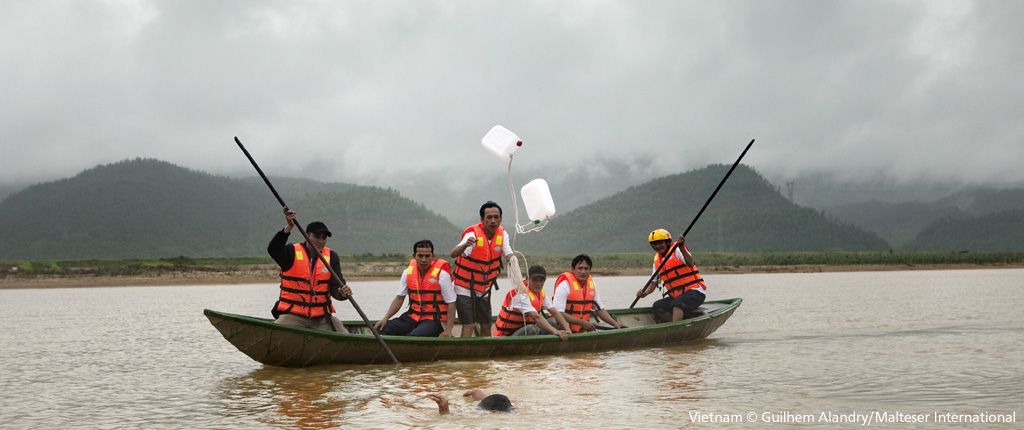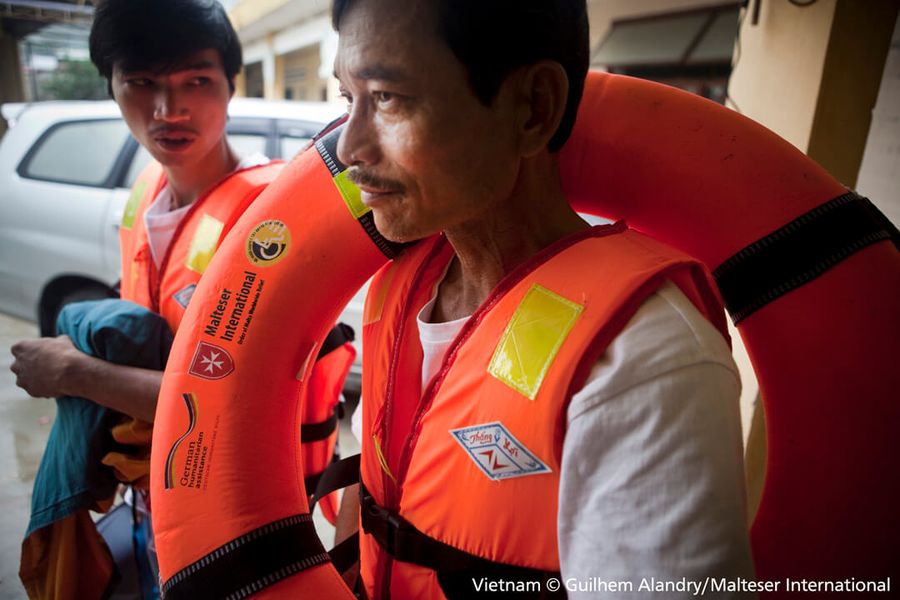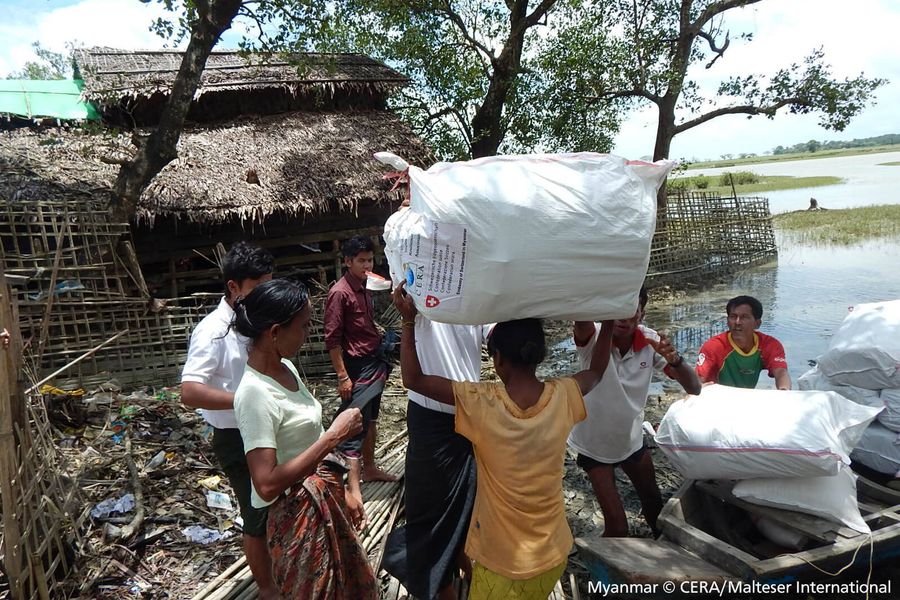Disaster preparedness
We prepare people for natural disasters and strengthen the resilience of local communities.
Learn more
Flood disasters pose a serious threat to people: it is becoming increasingly common for coastal and river levels to be significantly exceeded and parts of the country to be flooded. As many bodies of water are surrounded by cultivated landscapes and cities, major floods often claim many lives and destroy the livelihoods of thousands of people.
Malteser International supports those affected by providing rapid emergency aid during the floods, helping to rebuild the destroyed infrastructure and providing disaster preparedness, for example by training people to prevent recurring floods and practising what to do in an emergency.
The risk of floods is increasing as a result of climate change, such as heavier rainfall or melting snow. In addition, floods are often caused by human intervention in natural river courses, for example by straightening or embanking bodies of water.
There are essentially three different types of floods: River floods, storm surges and flash floods.
River flooding is usually the result of heavy and prolonged rainfall. When the water can no longer be absorbed by the surrounding nature, it flows into the watercourse and the water level rises. Rapidly rising water levels mean that even riverbeds and dykes can no longer hold back the water, so that areas in the immediate vicinity are flooded. Such floods can last for several days or even weeks.
During a storm surge, the water of seas or lakes is driven to the coast or shore by strong winds. As the high waves can flood the land and cause flooding, caution is advised, especially in coastal areas. A storm surge must be distinguished from a tsunami, as a tsunami is the result of an undersea earthquake and is therefore not a tide in the classic sense.
Flash floods are caused by extremely heavy rainfall and storms when the accumulating water can no longer be absorbed by the ground - sometimes even far away from larger bodies of water. The flooding usually occurs within a very short time and is therefore almost impossible to predict. This makes it particularly difficult to prepare for a flash flood.
Many countries in Asia are prone to flooding and inundation. In addition, due to the high population density, a large number of people are affected by the devastating effects of a flood disaster. Many flood victims lose their entire livelihood - if not their lives or those of their loved ones. In some cases, severe flooding leaves entire villages uninhabitable.
The precise extent of flood disasters only becomes clear when the water recedes. In most cases, it is not only houses and properties that are damaged or destroyed, but also the fields, crops and livestock of local farmers.
The risk of disease is also particularly high after a flood disaster, as the local water is heavily contaminated. This contamination leads to unhygienic conditions, which also encourage the transmission and spread of diseases.

We place great importance on preparing vulnerable communities and local authorities for floods and flood disasters in order to minimize damage in the event of an emergency. This preventive flood aid is primarily about building a flood-resistant social infrastructure.
Dazu gehören Schulungen zum Thema Katastrophenvorsorge, aber auch Aufklärungsmaßnahmen zum Thema Hygiene. Durch praktische Trainings und Simulationsübungen wird außerdem das Verhalten im Ernstfall geThis includes training courses on disaster preparedness, as well as educational measures on the subject of hygiene. Practical training and simulation exercises are also used to rehearse what to do in an emergency. Our training courses are aimed at particularly vulnerable population groups, such as people with disabilities.
Generally, how well the populcation can prepare for an emergency also depends on the type of flood. While a river flood develops over time so that preventative measures can be taken, storm and flash floods occur so unexpectedly that action can often only be taken after the flood.
After a flood disaster, we support the population with the aim of securing people's livelihoods, restoring livelihoods and reducing health risks. For example, we distribute hygiene kits, water disinfectants and, in risk areas, mosquito nets and mosquito control products to prevent the transmission of diseases.
Reconstruction includes the renovation and repair of buildings and public facilities as well as the provision of sanitary facilities. Elevated wells and latrines ensure that the water is not so heavily contaminated during a flood and therefore remains safe to drink.
In Germany alone, heavy rainfall has already led to increased river flooding and inundation. In July 2021, parts of Germany, particularly Rhineland-Palatinate and North Rhine-Westphalia, experienced a devastating flood of the century. More than 180 people died and many were injured. Thousands lost all their belongings. The destruction caused billions in property damage. Immediately after the disaster, Malteser Germany was on the ground with disaster relief workers, and even after the acute phase is over, we continued to support the people affected with psychosocial aftercare, initial financial aid and reconstruction.

Back in 2013, Germany experienced one of the biggest flood disasters of recent decades in terms of duration and severity. Following heavy rainfall, Bavaria, Saxony, Saxony-Anhalt and Thuringia were particularly affected by flooding. The damage to property is estimated at more than twelve billion euros. Immediately after the floods, we took action together with the German Malteser Aid Service to help those affected to rebuild their lives and improve their quality of life. The measures ranged from psychosocial to financial support.
In addition, Asia is particularly vulnerable to natural disasters and floods due to its geographical conditions and high population density, which put millions of lives and livelihoods at risk. Extreme weather conditions and prolonged monsoon rainfall have repeatedly triggered severe flooding in parts of the continent in recent years.
In August 2015, twelve regions and more than 1.6 million people in Myanmar were affected by severe flooding. Almost 385,000 houses were damaged or completely destroyed and at least 117 people lost their lives.
In August 2017, relentless monsoon rains triggered devastating floods in India, Nepal, and Bangladesh. In India alone, up to 30 million people were affected, with many forced to flee their homes. We support communities in rebuilding and strengthening their resilience against future natural disasters.
We prepare people for natural disasters and strengthen the resilience of local communities.
Learn moreAfter extreme natural events and in other crisis situations, we provide effective relief for the people on the ground.
Learn more